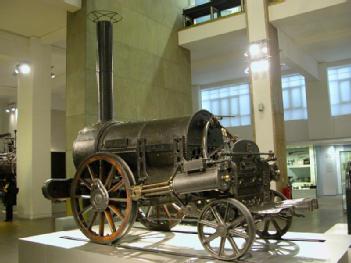
  |
Science Museum London |
SW7 2DD London, Great Britain (UK) |
|
| Address |
64, Exhibition Road
South Kensington |
| Floor area | unfortunately not known yet |
Science Museums in general
- Passenger cars
- Steam engines/generators/pumps
- Navy / Watercraft
- Typewriter, calculating and coding
- Surveying Equipment
- Agricultural
- Clocks and Watches
- Trucks / Lorries
- Air and Space (aviation, spaceflight etc.)
- Model Aircraft and Aviation
- Imax & "Maxi screen"
- Technical and functional models
- Technical Museum in general
- Radios (Broadcast receivers)
- Telephone / Telex
- Computer / Informatic
- Railway
- Biology / Medicine
- Morse technology
- Radar
- Lamps and Light
- Amateur Radio / Military & Industry Radio
- Physics
- Home Appliances
- Tractors
- Astronomy
|
Opening times
|
daily: 10.00 - 18.00, except 24 - 26 December | ||||
|
Status from 12/2022
|
Free entry, donations welcome. | ||||
| Contact |
|
||||
| Homepage | www.sciencemuseum.org.uk | ||||
| Location / Directions |
By UndergroundThe nearest tube station (10 minutes walk) is South Kensington on the District, Circle and Piccadilly lines. A pedestrian subway runs directly from the ticket barrier at South Kensington station to the Main Entrance of the Museum.Gloucester Road tube station is a 15 minute walk away and is based on the Circle, District and Piccadilly line. By BusBus routes 14, 49, 70, 74, 345, 360, 414, 430 and C1 stop outside South Kensington Underground Station, from where it is a five minute walk north to the Museum's Main Entrance.Buses from South KensingtonBus routes 9, 10, 52, 452 and 70 stop outside the Royal Albert Hall on Kensington Gore, from where it is a five minute walk south to the Museum's Main Entrance.By CarPlease be advised that the Museum itself does not offer any car parking and local parking is extremely limited.There is no visitor parking in Exhibition Road. The nearest pay and display bays are in Prince Consort Road and Queen's Gate. Please see the Royal Borough of Kensington and Chelsea's website for more details. By BicycleDetailed route planning for journeys to the Science Museum by bicycle, including printable maps and the option to travel where possible on cycle routes, is available from the Transport for London Journey Planner.Barclays Cycle Hire docking stations are also available near the museum on Queensgate Mews, Prince Consort Road and Thurloe Place. More information is available on the Transport for London Barclays Cycle Hire webpage. The museum does not have dedicated bicycle stands, though folding bicycles can be left in the cloakroom on the lower ground floor, which is accessible by lift from the main entrance. |
Some example model pages for sets you can see there:
Some example tube pages for sets you can see there:
| Description | The Science Museum has over 300,000 objects in its care, with particular strengths in the history of western science, technology and medicine since 1700. ComputingThese collections cover electronics, information and computing, mechanical computing, media technologies, networks including the internet, printing, radio, satellites, sound reproduction, software and telephony. The Telecommunicationsgallery is a must for anyone looking to discover the many uses of the electric telegraph, the telephone and radio. AgricultureThe Agriculture gallery is divided into three bays of exhibits. The first presents a history of agriculture told with the aid of delightful landscape dioramas and superb scale models. The many ways of powering the plough are explained alongside a working demonstration involving four tiny tractors. The Challenge of Materialsgallery is home to a whole range of fascinating objects. Energy HallFor over 300 years steam has been the driving force behind British trade and industry. Even now, steam turbines generate the majority of the electricity we use every day, both at home and at work. Exploring SpaceThe Exploring Space gallery contains a host of rockets, satellites, space probes and landers. FlightShare the dreams of the flight pioneers: see the development of aviation from its tentative beginnings to the modern era of mass air travel. Medical HistoryHere, via a mixture of reconstructions and dioramas, you’ll discover nearly forty vivid 3D snapshots from the history of practical medicine. Making the Modern WorldThis unique, breathtaking gallery chronologically presents 150 of the most significant items from the Science Museum's collections from 1750 to 2000. MathematicsThe Mathematics gallery combines instruments used by working mathematicians – such as slide rules, drawing instruments and early analogue computers. PsychologyThe Psychology exhibition marks the centenary of the British Psychological Society. Through an exciting range of objects, artworks, audiovisuals and an interactive it sets out the essential techniques that most psychologists use in their everyday practice. The Science and Art of Medicinegallery, one of the world's greatest collections on the subject, reveals the history of medicine across the world and across cultures. Science in the 18th CenturyIn the Science in the 18th Century gallery you’ll discover how science spread beyond the elite circles of the Royal Society to reach large sections of the population during this remarkable period in our history. The Secret Life of the HomeThe Secret Life of the Home gallery takes a close look at the development of those household gadgets and appliances that we use every day but often take for granted. Measuring TimeTime is precious. Before mechanical clocks, people used sundials, water clocks and sandglasses to keep track of time. Veterinary HistoryBy focusing on animals, the Veterinary History gallery provides a fascinating contrast to the large human-centred Science and Art of Medicine gallery. |
| Description (other) |
Explorer ticketMake the most of your visit by booking an Explorer ticket. Take advantage of this great deal which allows entry to one IMAX film, one ride in Legend of Apollo at the Force Field 4D theatre, one ride in Red Arrows 3D, a guidebook and a donation to the Museum. |
[dsp_museum_detail.cfm]
| Data Compliance | More Information |





